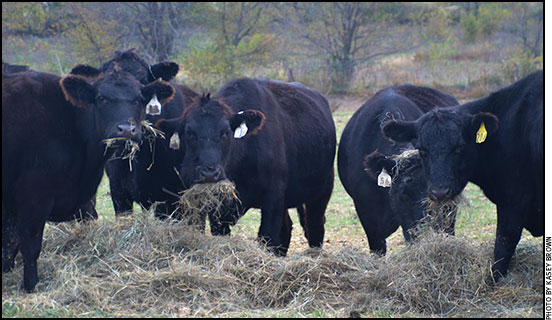
Winter Nutrition for the Pregnant Cow
The long-term ramifications of being short of protein and energy can carry over for up to two years.
Cows need more and better-quality feed as pregnancy progresses. Nutrient requirements in early gestation are not much different from maintenance requirements, but as the fetus grows larger, the cow’s nutrient needs increase. After calving, when a cow is lactating, she needs a much higher level of protein and energy than when she is pregnant.
Young cows’ requirements are highest because they are still growing. A heifer should be about 85% of her projected mature body weight at breeding, according to Beef and Forage Specialist Barry Yaremcio with Alberta Agriculture and Forestry. During her first pregnancy, the heifer needs to grow a calf and herself at the same time.
For the average beef cow [1,100 to 1,600 pounds (lb.)] the protein requirements in mid-gestation, late gestation and after calving would be a minimum of 7%, 9% and 11% respectively, on a dry-matter basis.
“Energy requirements, as a percent of TDN (total digestible nutrients), should be 55%, 60% and 65%, respectively, for those same stages,” he says.
There is a major change from the last trimester of pregnancy to lactation. The cow’s nutrient requirements jump by about 25% after calving to maintain lactation.
During winter, cattle also need to increase feed just to maintain body heat in cold weather. It helps if they go into winter in good body condition. Fat acts as insulation; the cow won’t need as much feed to keep warm. Fat can also be mobilized for heat energy if needed.
“If pastures are running out, some cows are losing condition. A cow that’s one body condition score lower than it should be will have trouble regaining weight during winter without supplement. For the thin cow to stay warm, she will require an extra 1,400 pounds of hay compared to a cow in proper body condition. She needs that much extra hay just to stay warm and hold her own, without gaining weight. That’s one extra big round bale per cow through winter, and that’s a major expense,” he says.
It pays to keep cows from losing weight in late fall.
“If a cow is thin, and doesn’t produce the quantity and quality of colostrum needed by her calf, there is a greater risk for the calf to get sick. Passive immunity from cows to their calves will be compromised, and the ability of the calf to resist diseases will be reduced,” he explains.
The thin cow won’t milk adequately.
“Peak lactation occurs during the first eight weeks, and it can be difficult to meet the energy requirements of the cow. If energy needs aren’t met, she’ll take the fat off her back and lose more weight. If she’s thin it will affect reproduction and breed-back. For every pound of fat that the cow mobilizes off her back, there’s enough energy in that fat to produce 7 pounds of milk. For a newborn calf, 7 pounds of milk is what’s required to gain 1 pound of weight per day. So basically the cow and the calf are trading weight, pound for pound, at that point in time,” he says.
If you don’t have some fat on the back of the cow to produce that extra energy, the calf won’t grow as well. Pay special attention to the first-calf heifer because she can’t consume as much feed as a larger cow.
“The goal for after-calving nutrition is to have the cow on an increasing plane of nutrition to maintain or gain a little weight each day. If a cow is in good condition and she loses a pound of fat per day for one or two weeks, it’s no big deal. But if she is thin and loses more weight, it will negatively affect reproduction,” he says.
“A thin cow or a cow losing weight after calving will take between 30 and 60 days longer (than a cow in good condition) to be physically prepared to have her first heat cycle,” says Yaremcio. She may be late calving or open the next year, in a 45- to 63-day breeding season.
“First-service conception rate on thin cows is roughly 20% to 25% lower than a cow in good condition. The long-term ramifications of being short of protein and energy and having thin cows this fall may carry over for a year or even two years, until reproductive efficiency is back to normal,” he says. If feed quality is low, pregnant cows will need some kind of supplement through winter.

Editor’s Note: Heather Smith Thomas is a cattlewoman and freelance writer from Salmon, Idaho.






